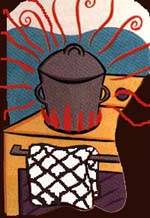|
|
Pasta

In nearly
all recipes for pasta, as
well as the numerous varieties of pasta dishes, the first steps in
their
preparation for the table are practically the same, for all of these
foods pasta and sauce must be cooked to a certain point and in a
certain way before
they
can be used in the numerous ways possible to prepare them. Therefore,
in
order that success may be met in the preparation of the pasta dishes
that are
made from these foods, these underlying principles should be thoroughly
understood.
In
the first place, keep in mind that while the time
required to cook the pasta depends on its composition and
dryness, dry pasta should be always cooked according to package
directions.
Many
pasta types are made of the same pasta dough and differ
only in the
shape of the pieces. However, the shape usually affects cooking time,
consistency, ability to hold sauce, ease of eating, etc. Therefore,
certain shapes are better suited for certain dishes, and such pairings
may be part of certain cooking traditions.
Most pasta dishes can provide a
quick and delicious meal for whole family in
less than 30 minutes.
Browse Recipes:
|
|

|
Did You Know?
|
Under Italian law, dry
pasta (pasta secca) can only be made from durum wheat flour or durum
wheat semolina.
There are approximately 600 different shapes of pasta. Examples include
spaghetti (thin rods), macaroni (tubes or cylinders), fusilli (swirls),
and lasagne (sheets).
Pasta is categorized in two basic styles: dried and fresh. Dried pasta
made without eggs can be stored for up to two years under ideal
conditions, while fresh pasta will keep for a couple of days in the
refrigerator.
A widely noted, finished consistency of pasta is called al
dente (Italian for to the tooth), soft but with texture, sometimes even
with bite in the center.
Traditionally most spaghetti was 50cm (20ins) long, but
shorter lengths
gained in popularity during the latter half of the 20th century and now
spaghetti is most commonly available in 25-30cm (10-12in) lengths.
In
cooking, the Italian expression al dente describes pasta and (less
commonly) rice or beans that have been cooked so as to be firm but not
hard. "Al dente" also describes vegetables that are cooked to the
"tender crisp" phase - still offering resistance to the bite, but
cooked through. It is often considered to be the ideal form of cooked
pasta.
|
|